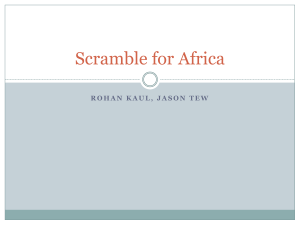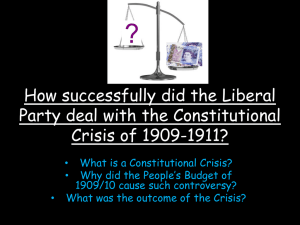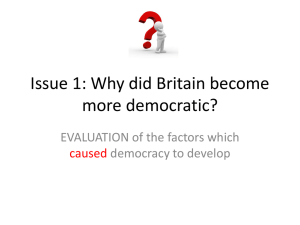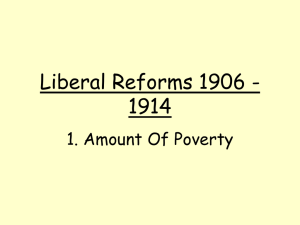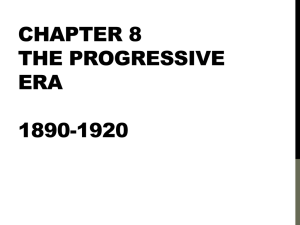1884 Reform Act - History @ St Benets
advertisement
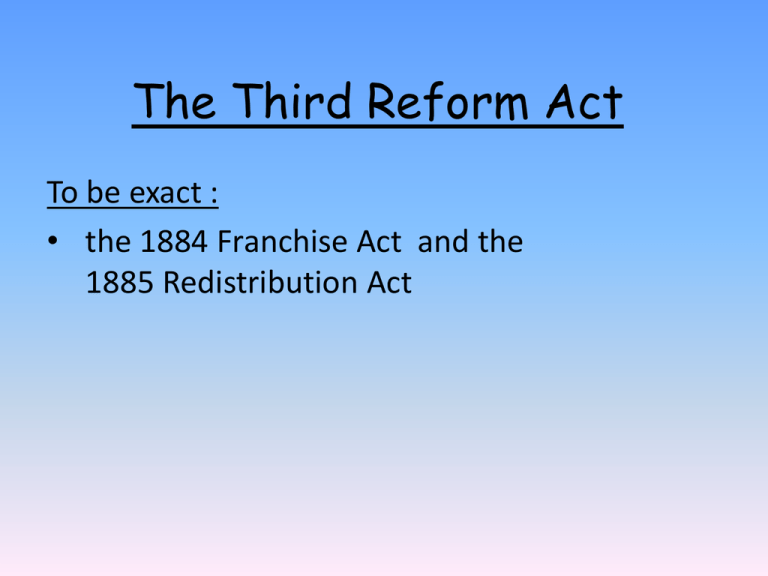
The Third Reform Act To be exact : • the 1884 Franchise Act and the 1885 Redistribution Act Why was the Third Reform Act passed? Learning Objectives: • To consolidate learning about the reasons for the passing of the Acts • To understand the controversy over the Acts • To learn about what the Acts said Can you remember the terms of the 1832 and the 1867 Reform Act? Discuss in your groups and note down your answers 1832 1. Increased number of voters by 50% to 652,000 2. Small boroughs lost 1 or both MP’s and larger towns gained 1 or 2 3. County £2 qualification stayed but tenants of property worth £50 a year could also vote 4. Boroughs men who had property worth £10 a year could vote 5. Voters now had to register 1867 1. Only 1 year residence qualification needed 2. As well as a householder franchise, a £10 lodger franchise. 3. Vote given to Compound Householders (those who paid rates & rent to a landlord) 4. No Fancy Franchises Bubble map Reasons for reform in 1884 Describing Qualities: functions as a descriptive organiserthe concept goes on the centre and all around in the circles go adjectives or qualities of the central concept. Extra Reasons What model of change are they veering towards? Spread of Literacy Gladstone thought reform would make his govt popular Liberal Associations grew National Liberal Federation 1884/5 Acts Conservatives were against reform Fear of socialism No popular demand outside parliament Not much support for reform at 1880 election Whig influence declining Controversy Read Box 2.14 on page 58. • Highlight all the phrases that tell you this was a High Politics model of change Explain what each of these 3 people wanted:• Gladstone • Chamberlain • Salisbury Controversy Read Box 2.14 on page 58. • ‘strictly party reasons’ • ‘Liberal Party considerable electoral advantages’ • ‘redistribution measure’ • ‘Tories might win’ • ‘The Peers against the People’ Explain what each of these 3 people wanted:• Gladstone – create a uniform franchise in boroughs and counties, avoid public disorder, encourage electoral success for the Liberals • Chamberlain – to stir revolutionary feelings within the public to force reform in House of Lords • Salisbury – to force a redistribution measure and avoid the Liberals gaining power, reach a compromise, avoid public disorder, force and win a General Election Arlington Street Compact What was the deal? • Read the details about the Redistribution Bill and explain why Salisbury wanted it. • Write your own definition of “Villa Toryism” Explain why the chief victims of this act were the Whigs. • Use pages 72 and 97/98 in your other chapters to help. Arlington Street Compact What was the deal? • Salisbury would instruct the Conservative majority to allow the reform act to pass through Lords • Gladstone would introduce a separate Redistribution Bill Details about the Redistribution Bill and explain why Salisbury wanted it. • All constituencies should have an electorate of roughly the same size • The vast majority of constituencies should return a single MP • Salisbury was prepared to accept radical redistribution of seats as it would ensure Conservatives retained their domination in the counties but also thought there was a good chance of them winning votes in newly created middle-class constituencies Write your own definition of “Villa Toryism” • Conservative support from the lower middle-classes Explain why the chief victims of this act were the Whigs. • The Whig electoral success had depended on a Whig and a Radical being elected in Liberal two-member constituencies. In the new one-member constituencies Liberal voters would have to choose between a Whig and a Radical and there was little doubt about who would normally be chosen Redistribution Look at the cartoon on page 61; explain it. The 3rd Reform Act • Look at the terms on page 59 • Pick out the main statistics concerning how many men could now vote. • What key points make this a significant act? The 3rd Reform Act • Look at the terms on page 59 • Pick out the main statistics concerning how many men could now vote. • What key points make this a significant act? 1. Created a uniform franchise in both boroughs and counties and applied to the UK as a whole 2. All male householders who paid rates and had lived in the house for at least one year were enfranchised 3. All male lodgers who occupied lodgings worth £10 a year and had lived there for at least one year were enfranchised 4. All those who had land or property worth £10 a year were enfranchised 5. Increased the number of men eligible to vote from 3 million to nearly 6 million therefore 2/3 adult men could vote instead of 1/3 and the proportion of men with a vote became 18% (population was now 34.9 million) 6. Plural voting still took place by acquiring more than one property qualification 7. University graduates continued to have 2 votes Redistribution • How could you argue that this act tried to correct the flaws that still existed in the electoral system? Why was the Third Reform Act passed? Learning Objectives: • To consolidate understanding of reasons for reform • To begin to understand the motivation of politicians • To check understanding of terms of the Act • To begin to understand the impact of the Act Lord Salisbury Read the comments about him on page 200. • How does this add to your knowledge of why he helped to get the Reform Bill passed. • Read the source and identify the key points he is making. • What proof is there that this is high politics? 1884 Franchise Act: Terms • The franchise of the towns to apply to the counties (household suffrage) • A wider franchise not introduced • 1 year residential requirement • Plural votes for university graduates • Residuum still not included • 2.5 million extra voters – mostly farm labourers 1884 Act: Terms 1/3 of adult males still disenfranchised M.P.`s still not paid Electorate now stood at 5 million – 2 men in every 3. £10 Lodgers in counties also got the vote £10 Occupation Franchise for those who occupied shops and offices • Many agricultural workers and miners now got the vote. • By 1911 84% of the electorate was registered under the householder franchise • This legislation lasted until 1918 • • • • • Democracy • How near is Britain to a full democracy? • Is this Act more significant than 1867? 1885 Redistribution Act: Terms • 142 seats redistributed – radical • Constituencies made more equal in size; the principle of equal electoral districts. • Every 50,000 people to get an M.P. • Most constituencies after 1885 had a single M.P. • Old county divisions were cut into single member constituencies to correspond to the distribution of population. • Urban areas got more MP`s and counties got less • The sub-division of city constituencies created safe Conservative seats • The Liberals won the election in 1885 1885 Redistribution Act: terms • Each constituency was to represent a social and economic interest. • Some counties and boroughs were divided so that they were dominated by one class or another. • Large towns tended to vote in Tory M.P.`s (Villa Toryism) • It creates a framework for a classbased political system. Redistribution • How important was this Act for the Conservatives? Reasons for 1884 Act High Politics High Politics model • To unite the Liberals • To make the government popular • To ensure the Conservatives could pick up votes in the towns • To create an equal franchise between boroughs and counties High Politics Model • Competition between Chamberlain & Salisbury; opposition of the Lords. • Appointment of a Cabinet Committee to draft a redistribution scheme High Politics Model • Competition between Gladstone and Salisbury – Brinkmanship • strategic risk-taking: the practice of taking a dispute to the verge of conflict in the hope of forcing the opposition to make concessions. • The Arlington Street Compact Reasons for 1884 Act Low Politics Pressure from outside parliament • Popular politics revived • Spread of Literacy among the working classes • Public opinion shocked at corruption in elections • Miners insisted that further electoral reform was necessary if they were to continue to support the Liberals • Radicals held meetings in 1883 to arouse popular support for reform Pressure from outside parliament • Agricultural Depression 1870s • 13 October 1884 Aston Riots • Growing power of trade unions Easter Homework • Which political party gained the most? Research Liberals, Conservatives and Labour, make notes on gains and come to a decision Find out about each group and assess its importance: • 1877 National Liberal Federation • 1883 Social Democratic Federation • 1872 Chamberlain`s social programme • Growth of Trade Unions • Agricultural depression from 1870`s • 1884 Socialist League founded • 1884 Aston riots Pressure from outside parliament Find out about each group and assess its importance: • 1877 National Liberal Federation • 1883 Social Democratic Federation • 1872 Chamberlain`s social programme • Growth of Trade Unions • Agricultural depression from 1870`s • 1884 Socialist League founded • 1884 Aston riots Pressure from outside parliament Find out about each group and assess its importance: • 1877 National Liberal Federation Formed by Chamberlain and saw itself as a power to be reckoned with. Fatal divisions in the party led to creation of new Liberal Associations. • 1883 Social Democratic Federation Adopted an explicitly socialist platform. Strongly opposed to Liberal party which currently claimed to represent the Labour movement in Parliament. Strongly progressive and called for social reform. Formed by H.M.Hyndman and was inspired by Marx. • 1872 Chamberlain`s social programme Radical programme in preparation for next General Election, programme was to blazon across the country in speeches. Free primary education, land reform to break up great estates, financial reform to ease burden of taxation, county councils to democratise local gov. Longer term manhood suffrage, payment of MP’s • Growth of Trade Unions and Agricultural depression from 1870`s Made Conservatives nervous and anxious about power of trade unions and the “threat of socialism”. Rural labourers, persuaded by trade unions, might try to exploit the franchise. This might lead to further expenditure on poor relief, rural housing and free education. • 1884 Socialist League founded Members of SDF were unhappy with Hyndman’s leadership (his Nationalism and Dictatorial methods). 1884 league formed. Advocated revolutionary international socialism. Not large group and many members were unemployed and poor. • 1884 Aston riots Chamberlain did all he could to stir up Nationalist feeling in the country against the peers but success was limited. These riots were in Birmingham in 13 October 1884. Liberal mob invaded a Tory meeting and Lord Randolph Churchill and Sir Stafford Northcote had to flee for lives. Why was the Third Reform Act passed? Learning Objectives: • To consolidate understanding of reasons for reform • To check understanding of terms of the Act • To understand the impact of the Act on political parties Is there more evidence of High or Low politics being the reason for change? Using the sheet you have been given categorise each statement as examples of high politics, low politics or other. Now answer the question: Was the 1884 Reform Act caused by examples of low or high politics? In your answer refer to specific factual evidence. Which party do you think gained most and why? Using the evidence in your envelope you are going to: 1. Research the gains made for your designated group 2. Prepare a 2/3 minute presentation on your groups gained 3. Prepare an argument as to how your group could be considered to have made the biggest gain – this will be part of your presentation 4. Produce an A4 revision sheet showing your groups gains You have the Conservatives Liberals • • • • Darina Matthew F Dillon Leigh • Andrew • Reece • Shannah Other • • • • James G James S Adam Mark rest of this lesson and homework to complete this task. Evaluation What have your group done to prepare this? Have you identified the areas of gain for your group? Have you prepared an argument for how your group made the biggest gain? Have you designed a revision sheet which will inform the other groups and act as a revision aid? Is your presentation prepared and have you decided which role each of your members will take? What do you still need to do? Homework: Results of the Acts Look at pages 73-74 • Identify positive results of these Acts • Identify where the Liberals gained • Identify where the Conservatives gained • Identify where the Labour MPs gained • Identify where the middle classes gained • Identify who lost power and why What was the impact of the Third Reform Act on political parties? Learning Objectives: • To learn about which party gained the most after the reforms of 1884/5 • To be able to tackle an exam question on this topic Which party do you believe gained most? Liberals Conservatives Labour Tree Map Classifying: Ideal for classifying information given about a topic into its subtopics and details or for helping students to organise an essay. What was the impact of the Third Reform Act on political parties? The Liberals The Conservatives Labour The Liberal • 1885 Liberals returned as the largest party • In the Counties Liberal Candidates gained seats that were traditionally held by Conservatives • Used political missionaries from towns and cities to carry messages to the countryside • Gave more attention to the rural issues in order to appeal to farm labourers and were rewarded in 1885 General Election – as well as cycling clubs and land societies. Chamberlain’s unauthorised programme of 1885 – 3 acres and a cow • Liberal Party in Parliament became much more radical in policy and more middle class in background • Lib-Lab Pact 1903 • Revived after 1903 resulted in a landslide victory in 1906 – programme of social and welfare reforms and ‘New Liberalism’ from 1906-1914 The Liberals • 1885 Liberals returned as the largest party but lost overall majority • Character of party changed and in 1886 most Whigs left and allied with Conservatives. • Seats the Liberals had previously won in countryside had been secured by Whig landowners. • Faced new challenges after formation of Labour Representative Committee in 1900 • 1886-1906 – only held office for 3 years (1892-95) • WW1 – appeared weak and divided in peacetime politics The Conservative • Most successful party in period of 1886-1906 • Middle-class voting for Conservatives was consolidated • Some success appealing to working-class voters through perusing expansionist imperialist policy • Gained success on basis of war time records • 1883 Primrose League (Disraeli’s favourite flower) promoted the Tory principles of maintaining established Church, power of landed classes and Empire and made Disraeli into a Tory icon. By 1891 it had 1 million members. • Introduced a number of reforms of landholdings and local government such as – elected county councils in 1888, Allotments Act 1887, Smallholdings Act 1892 • Redistribution meant that there were significant gains in large urban towns in elections after 1885 • Success was based on winning extra seats in former Liberals heartlands of industrial areas • Huge victories in 1886, 1895 and 1900 accelerated embourgeoisement of party The Labour Party • 1888 Hardie set up the Labour Party in Scotland • 1893 – Independent Labour Party set up • 1906 – 29 Labour MPs elected - but struggled in socially mixed population • Dedicated to promoting independent Labour representation • Trade unions supported them and threatened their links with the Liberal Party and the threat contained by ‘Lib-Lab’ electoral pact between the 2 parties in 1903 • Gained support on basis of war time success • Began to give more attention to winning support in the countryside after beginning as an Urban Party • Appealed to working classes • Redistribution did create 89 constituencies with clear working class electorate – Labour targeted these The Whigs • After Redistribution the party suffered serious damage • The loss of the Whigs led to the radicalisation of the Liberals • Whigs used to share Liberal candidacies with the radicals but in single member constituencies the middle class Liberals dominated and were less inclined to give support to Whig candidates Women • Petition for women’s suffrage put forward by John Stuart Mill in 1866 and after this suffragist MP’s introduced Bills and resolutions to Parliament annually throughout 1870’s and 1880’s • Franchise Bill was debated in June 1884 by William Woodhall (Liberal) proposed an amendment to enfranchise women and was defeated by a majority of 136 – reflected official opposition of the government • Although the Bills were defeated there was a gradual conversion to the cause – when Woodhall introduced the same Bill in November he won a majority of 21 • 1880’s and 90’s women pursued a more prominent political role – women were given proof of their competence • By enfranchising poor and ill educated men in 1867 and 1884 politicians made it increasingly difficult to justify the exclusion of educated, property-owning, tax paying women Multi-Flow Map! Effect Causes The 1884 Reform Act and 1885 Redistribution Act Cause and Effect: The major function is to show causes- which can be sorted by root , immediate, proximal or long term causes- and their effects in relation to a major event; can be indefinitely expanded to include multiple cases. What caused the 1884 and 1885 reforms? Learning Objectives: • To understand how to answer a 40 mark question • To practice our skills at source analysis • To apply our knowledge of the 3rd Reform Act Sit in these groups please: 1. Leigh, Mark and Andrew 2. Dillon, Darina and Reece 3. Adam and James S 4. James G, Matthew F and Shannah In your groups annotate the question in order to: 1. Pick out key words 2. Develop understanding of the area of debate 3. Pick out any areas of contextual understanding that you may need to answer it Do you agree with the view that the changes in the electoral system which took place in 1884 and 1885 were due to competition between the parties to gain support from the working classes? What did the acts alter? What contextual knowledge do you have? 1884 Franchise Act 1885 Redistribution Act What did the acts alter? 1884 Franchise Act • • • • • • • • • • • • The franchise of the towns to apply to the counties (household suffrage) A wider franchise not introduced 1 year residential requirement Plural votes for university graduates Residuum still not included 2.5 million extra voters – mostly farm labourers but 1/3 of adult males still disenfranchised M.P.`s still not paid Electorate now stood at 5 million – 2 men in every 3. £10 Lodgers in counties also got the vote and £10 Occupation Franchise for those who occupied shops and offices Many agricultural workers and miners now got the vote. By 1911 84% of the electorate was registered under the householder franchise This legislation lasted until 1918 1885 Redistribution Act • • • • • • • • • • • • 142 seats redistributed – radical Constituencies made more equal in size; the principle of equal electoral districts. Every 50,000 people to get an M.P. Most constituencies after 1885 had a single M.P. Old county divisions were cut into single member constituencies to correspond to the distribution of population. Urban areas got more MP`s and counties got less The sub-division of city constituencies created safe Conservative seats The Liberals won the election in 1885 Each constituency was to represent a social and economic interest. Some counties and boroughs were divided so that they were dominated by one class or another. Large towns tended to vote in Tory M.P.`s (Villa Toryism) It creates a framework for a class-based political system. Each team has been given a source to annotate – you have 10 minutes and must then feedback Remember to: 1. Pick out key words or quotations 2. Develop understanding of which side of the debate the source falls upon 3. Pick out any areas of contextual understanding that you may need to answer it In your groups annotate the source in order to: 1. Pick out key words or quotations 2. Develop understanding of which side of the debate the source falls upon 3. Pick out any areas of contextual understanding that you may need to answer it SOURCE 4 (From David Cooper, Disraeli, Salisbury and the Conservative Party) The notion of a “Tory Democracy” struck Salisbury as a contradiction in terms. … It was, Salisbury believed, the main responsibility of the Conservative Party to keep the poor from the throats and pockets of the rich. … Salisbury`s strategy was … resistance to socialism and the cultivation of Villa Toryism. In your groups annotate the source in order to: 1. Pick out key words or quotations 2. Develop understanding of which side of the debate the source falls upon 3. Pick out any areas of contextual understanding that you may need to answer it SOURCE 5 (From a speech by Joseph Chamberlain in January 1885) Next year two millions of men will enter for the first time into the full enjoyment of their political rights. These men are for the most part your fellow-workers in factory and in field, and for the first time the toilers and spinners will have a majority of votes, and the control, if they desire it, of the Government of the country. To-day Parliament is elected by three millions of electors, of whom, perhaps one third are of the working classes. Next year a new House will come to Westminster elected by five millions of men, of whom three fifths belong to the labouring population. It is a revolution which has been peacefully and silently accomplished. The centre of power has been shifted, and the old order is giving place to the new. What did we pick up from the sources? Source 5 – support of working class Source 4 – support of middle classes • • • • “Tory Democracy” – Salisbury was not in favour of this, he wanted to delay the onset of democracy as long as possible – therefore his main concern was not gaining votes from working classes “keep the poor from the throats and pockets of the rich” – here he hints at the working classes criminal tendencies and wanted to retain the power of the aristocracy, he has no faith in the emerging working classes “pockets” – many middle class citizens felt their wealth was threatened by new socialist ideas “cultivation of Villa Toryism” – he wants to harness the middle class vote and by redrawing boundaries of constituencies he believed he could create areas of middle class support • • • • “your fellow-workers in factory and in field” – new franchise mainly affected the rural agricultural labourers and gave same rights as Urban workers “toilers and spinners will have a majority of votes” – focus on the newly enfranchised working classes and implies that they held power in government and the aim for Chamberlain is now manhood suffrage “revolution which has been peacefully and silently accomplished” – compared to 1832 and 1867 the 3rd Reform Act was the least dramatic, politicians began to believe the onset of democracy was inevitable – low model of change? “centre of power has been shifted” – impact of widening franchise You now have 10 minutes to write a paragraph about your source which answers part of the question. Remember to: • Say whether your source supports or challenges the question • Use source details to support your answer • Apply your contextual knowledge to the source details and your answer Switch answers with a different team. In 3 different colours highlight where they have done each of the below in the answer Remember to: • Say whether your source supports or challenges the question • Use source details to support your answer • Apply your contextual knowledge to the source details and your answer Now offer two pieces of advice which could improve their answer. Next lesson you will be doing this as a practice essay on your own • Use the methods we have used today and the materials you have been given to revise and prepare.
